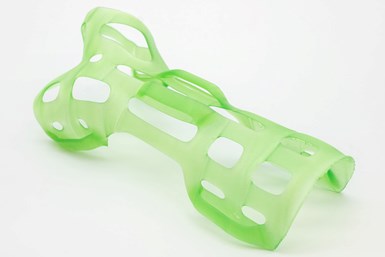Altana Launches 10 Resin-Based Cubic Ink Materials for 3D printing
The new resins in the Cubic Ink family of 3D printing materials are focused on system-open and industry-applicable additive manufacturing across DLP, LCD and SLA technologies.
Altana says it is giving shape to new ideas by enabling additive manufacturers to turn product designs into reality with its new and enhanced resin-based Cubic Ink 3D printing materials. Among them is a material for stereolithography (SLA) applications — Cubic Ink High-Performance 2-1400 VP.
With the new products, specialty chemicals group Altana says it is significantly extending its Cubic Ink 3D printing material family for high-performance resins. The expansion positions the company as a supplier of manufacturer-independent, open-system materials suitable for Digital Light Processing (DLP), Liquid Crystal Display (LCD) and SLA applications, as well as inks for material jetting.
The company says this development unlocks entirely new opportunities for users, particularly in the automotive and aerospace sectors. It is also a boon for the medical technology field, encompassing audiology, dental medicine and orthopedics as it can enhance their product manufacturing processes.
“Altana is focusing its Cubic Ink family of 3D printing materials on system-open and industry-applicable additive manufacturing across DLP, LCD and SLA technologies,” says Dr. Max Röttger, head of Cubic Ink. “Our customers reap the rewards of our extensive solution expertise in pioneering high-performance materials. Furthermore, we offer dedicated support to our customers in the development and formulation of high-performance inkjet inks for material jetting.”
Mold 210 VP and 601 VP are two materials in the Cubic Ink series which were designed for resin printing. These materials offer a multitude of advantages in both the printing process and postprocessing stages. The materials are used, for example, in the manufacture of hearing aids. Their low viscosity enables rapid printing, and the printed molds can be effectively cleaned using common washing solvents, such as IPA. Furthermore, after approximately 10 minutes of UV post-exposure, these materials are ready for filling with the corresponding molding compound.
Another innovative material is the Cubic Ink High-Performance 4-1301 VP for medical technology applications. The material has been tested for its non-cytotoxic properties by accredited testing laboratories for medical technology. The results of these tests show the material is well-suited for medical technology applications with direct skin contact, such as orthoses for fingers or arms.
Cubic Ink High Performance 4-2800 VP-ESD debuts in the segment of electrostatic dissipative materials (ESD)-compliant, or antistatically designed, printing materials. The resin is engineered for crafting items that possess electrostatic dissipative properties, effectively mitigating the risk of sudden voltage discharges in sensitive electronic components. These materials are used primarily in the handling and manufacture of electrical or electronic components, shielding them from damage caused by uncontrolled electrostatic voltage discharges.
This resin can be processed efficiently and swiftly because of its low viscosity. After printing, it can be cleaned with water and exhibits commendable mechanical properties following posttreatment. It also has good reactivity and electrical conductivity, with a surface resistance of 1.8 × 107 Ωcm, as measured under laboratory conditions.
Cubic Ink High-Performance 4-2100 VP features exceptional impact strength and heat resistance. This low-viscosity material enables fast and precise printing, while its flexibility makes it especially well suited for the manufacture of production aids, including sturdy internal components for industrial grippers.
- To learn more about the multitude of materials used in additive manufacturing, check out our Materials section.
- Read more about Material Jetting in this overview from Tim Simpson, a Paul Morrow Professor of Engineering Design & Manufacturing at Pennsylvania State University.
Related Content
3D Printing with Plastic Pellets – What You Need to Know
A few 3D printers today are capable of working directly with resin pellets for feedstock. That brings extreme flexibility in material options, but also requires greater knowledge of how to best process any given resin. Here’s how FGF machine maker JuggerBot 3D addresses both the printing technology and the process know-how.
Read MoreQ&A With Align EVP: Why the Invisalign Manufacturer Acquired Cubicure, and the Future of Personalized Orthodontics
Align Technology produces nearly 1 million unique aligner parts per day. Its acquisition of technology supplier Cubicure in January supports demand for 3D printed tooling and direct printed orthodontic devices at mass scale.
Read MoreThis Drone Bird with 3D Printed Parts Mimics a Peregrine Falcon: The Cool Parts Show #66
The Drone Bird Company has developed aircraft that mimic birds of prey to scare off problem birds. The drones feature 3D printed fuselages made by Parts on Demand from ALM materials.
Read MoreConcept Sneaker Boasts One-Piece 3D Printed TPU Construction
The Reebok x Botter Concept Sneaker Engineered by HP premiered at Paris Fashion Week, hinting at manufacturing possibilities for the future of footwear.
Read MoreRead Next
3D Printed Polymer EOAT Increases Safety of Cobots
Contract manufacturer Anubis 3D applies polymer 3D printing processes to manufacture cobot tooling that is lightweight, smooth and safer for human interaction.
Read MoreCrushable Lattices: The Lightweight Structures That Will Protect an Interplanetary Payload
NASA uses laser powder bed fusion plus chemical etching to create the lattice forms engineered to keep Mars rocks safe during a crash landing on Earth.
Read MoreAlquist 3D Looks Toward a Carbon-Sequestering Future with 3D Printed Infrastructure
The Colorado startup aims to reduce the carbon footprint of new buildings, homes and city infrastructure with robotic 3D printing and a specialized geopolymer material.
Read More





















